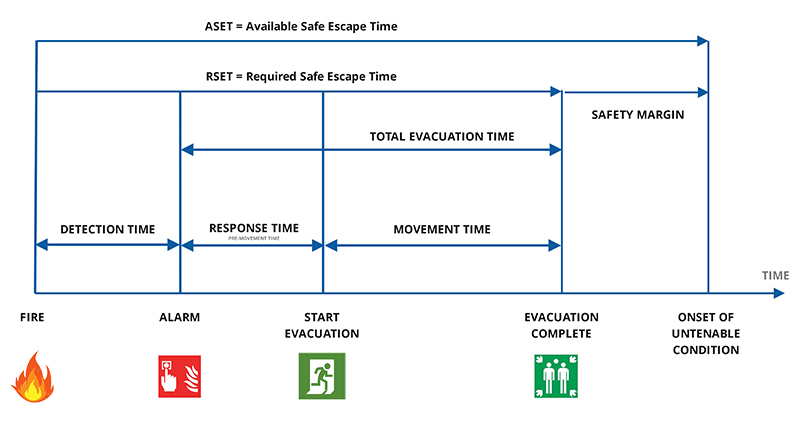Time to evacuate
ASET vs RSET
Fire engineers commonly use the ASET vs RSET analysis to assess the safety of a building. ASET represents the Available Safety Egress Time, while RSET stands for Required Safety Egress Time. This method involves comparing the time required to evacuate a building during a fire with the available time to exit. If the available time is greater than the required time, the building is considered safe for its occupants.
To conduct the analysis, the ASET and RSET are calculated separately, and their results are then compared to determine the overall safety of the building. Various tools are available to calculate each component of the analysis. For instance, ASET can be determined using CFD models, 2-zone models, or manual calculations. Likewise, RSET can be estimated using evacuation simulation software or manual approximations. FPC Risk is equipped to perform CFD calculations and use evacuation models to calculate both ASET and RSET accurately, ensuring a reliable analysis for any building layout.
ASET
The ASET is the time the occupants have before the conditions in the building become untenable for their safe egress. My colleague Laura is responsible for conducting the CFD calculations used to determine the ASET component of the analysis. She has written an informative article on CFD and its application in this type of analysis, which can be found here.
Once these calculations are completed, the available time for building occupants to evacuate can be extracted and used in the ASET/RSET analysis.
RSET
FPC Risk uses evacuation simulation software to determine the RSET. This software simulates a building’s layout and occupancy to calculate the evacuation time for its occupants.
The software utilizes the velocity of people to determine the time it takes them to move through the layout and reach the nearest exit. The software requires at least the following information to run the simulations:
- Type of occupation in the building. (Offices, shopping centre, residential)
- Characteristics of the evacuees (age, mobility, agility)
- Layout of the building (obstacles, available exits)
- Capacity of the exits
- Time to evacuation alarm
The RSET time is divided as shown below:

The image above explains that the total evacuation time from a building is the sum of the time it takes for the fire to be detected and the evacuation alarm to be activated, the time it takes for people to respond to the alarm, and the time it takes for them to reach an exit or a safe location.
The choice of reaction and alarm times is dependent on various factors. These values, along with the required input for the simulation software, must be carefully considered to ensure that the results accurately represent reality. Therefore, the input of a fire or evacuation specialist is essential to make accurate assumptions.
Once both the RSET and ASET are determined, a comparison and overall analysis can be conducted. The outcome of this analysis is the current level of safety in the building and the necessary actions to improve it.
The ASET/RSET analysis is typically required to:
- Assess the safety of existing buildings and their current safety measures
- Improve and evaluate the fire and evacuation systems and plans.
- Evaluate the maximum occupational capacity of a building.
- Demonstrate that atypical buildings are sufficiently safe, even if they do not comply with current prescriptive regulations.
The benefits and applications of this analysis, if performed accurately, are numerous. Therefore, it is best to leave it in the hands of real experts in the field who can accurately assess your building. FPC Risk's extensive experience ensures a complete and reliable analysis that accurately represents the conditions and characteristics of your building, optimizing its safety.
Time to act!
FPC Risk can be your trusted partner to conduct the ASET/RSET analysis for your project. By choosing our services, you can expect the following benefits:
- Accurate digital simulations and analysis of potential fire scenarios
- Thorough evaluation of the existing fire safety systems
- Insights on evacuation scenarios, identifying potential bottlenecks and obstacles that may impede the smooth evacuation of people.
- Improved safety of assets and individuals during the design stage of your project.
- Determination of the maximum number of people that can be safely accommodated in each area of the structure.
- Support for derogation requests with multiple simulations and analyses, ensuring a comprehensive and reliable assessment of your building's safety

Manuel Antonio Osorio Quintana
Fire Risk Engineer
FPC Risk Ghent
More information?
Contact us
References

